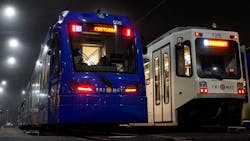TriMet rolls out two Type 6 MAX trains
TriMet rolled out two of its new Type 6 MAX trains on Jan. 16. The agency notes 30 new vehicles will enter service in the months ahead, operating on all five MAX lines. TriMet says the Type 6 MAX trains are the agency’s most advanced trains and are part of an overall effort to boost reliability and the rider experience. According to the agency, the trains are also the first to not enter service alongside an extension of the MAX system.
Better rides, more reliability
TriMet notes that on the outside, the newest trains look similar to the Type 5 vehicles, which were introduced in 2015 when the MAX Orange Line opened. According to the agency, both trains are manufactured by Siemens Mobility. They’re the same length – 96 feet, 11 inches – and the same width – eight feet, eight inches. They’re also both blue with orange stripes.
The agency notes the difference is on the inside. The Type 6 vehicles include:
- Video-enabled destination screens: On the ceiling are digital destination displays, enhanced by graphics and video. TriMet notes the screens not only show the station the train is approaching, but they’re capable of displaying special messages and video packages. By using improved accessibility features, riders will have more information available to them as they ride.
- Improved lighting and temperature control: New LED lights around the doors indicate when the trains are available for boarding and getting off trains. The lights will display in green when a door is ready for use, red when it’s closed and cannot be used and flash yellow when the doors are operating to provide better visual aids for riders. TriMet says improved temperature controls will help the trains stay cooler in the summer and warmer in the winter.
- Predictive maintenance for reliability: According to TriMet, the trains have the ability to use predictive maintenance to improve their reliability. Sensors in the trains will communicate digitally with TriMet maintenance teams, giving them better information to troubleshoot and solve issues before they occur.
- Advanced security system: TriMet notes on board security cameras are better as well, as they will provide clearer pictures and feature wireless data for remote downloading of footage.
According to TriMet, every Type 6 train is labeled with a three-digit number that starts with six. From the outside of the train, the number is on the top near the light and on both sides of the vehicle. Inside, the train number is displayed on both ends near the operator cab.
Introducing a better MAX
TriMet notes the introduction of the Type 6 MAX trains means the first generation MAX trains will retire. The agency says the old trains have been a reliable source of transportation for riders across the MAX system since 1986, a 39-year period where some of the trains have surpassed two million miles.
According to the agency, the decommissioning process for the Type 1 trains began when the first Type 6 trains began arriving for their extensive testing period in June. TriMet will continue phasing out the original Type 1 vehicles in 2025. According to TriMet, not only have the Type 1 trains exceeded their lifespan, but parts for the vehicles are no longer available.
TriMet plans to donate one of the Type 1 trains to the Oregon Electric Railway Museum in Brooks, Ore., for preservation.
Improving the overall system
TriMet notes it has been working on ways to reduce travel times and improve the overall rider experience on MAX. Recently, the multi-year A Better Red MAX Extension and Reliability project was completed, with the extension of the MAX Red Line to Hillsboro opening to riders on Aug. 28, 2024.
Along with major reliability projects aimed at improving the light-rail system, TriMet has also invested in enhanced cleaning efforts focused on the MAX system. TriMet notes its Clean Team is out every day, power washing, removing graffiti, picking up litter and more to make its facilities feel safe and welcoming.
The agency notes it has also added more safety and security personnel, along with other safety resources, such as its Security Operation Center and blue-light security phones for reporting issues.
